The Blue gourami (Trichopodus trichopterus) is a color variant of the popular Three Spot gourami. The only difference between the two is that the Blue gourami has a whitish-blue, hazy coloration.
These fish are not only beautiful, but they’re hardy, too, making this species the ideal choice for a beginner. Blue gouramis are also quite long-lived when compared to other aquarium fish.
But what size tank do you need for Blue gouramis? Are these fish aggressive? And what fish make suitable Blue gourami tank mates?
Read this guide to find out everything you need to know about keeping these gorgeous tropical fish.
Blue Gourami – Species Overview
Scientific Name
Trichopodus trichopterus
Common Name (species)
Blue gourami, Gold Gourami, Three Spot gourami, Siamese Gourami, Opaline gourami, Cosby Gourami,
Family
Osphronemidae
Origin
Southeast Asia and Indonesia
Diet
Omnivore
Care Level
Easy
Activity
Active
Lifespan
Up to 5 years
Temperament
Peaceful
Tank Level
Mainly the middle to the top of the water column
Minimum Tank Size
20 gallons
Temperature Range
Tropical 73° to 82° Fahrenheit
Water Hardness
5 – 35 dGH
pH Range
6.0 to 8.8
Filtration/Flow Rate
Good filtration and slow flow rate
Water type
Freshwater
Breeding
Egg-layer and can be bred in captivity
Compatibility
Peaceful community fish although can be aggressive when spawning
OK, for Planted Tanks?
Safe with plants
Origins
Blue gouramis are a naturally occurring variant of the Three Spot gourami and were first described way back in 1770 by Pallas.
These fish are very widely distributed throughout southeast Asia and Indonesia, being found mainly in Vietnam, Laos, the River Mekong basin, Cambodia, Myanmar, Thailand, and Malaysia. Introduced populations are also seen outside the fish’s native range in diverse locations, including Taiwan, the Philippines, Papua New Guinea, Namibia, Colombia, the Dominican Republic, and the Reunion Islands.
Despite being super-popular as pets worldwide, the Blue gourami is also used as a food fish, processed, dried, and salted. Most of the specimens you find for sale in the trade today are commercially bred in Eastern Europe and the Far East.
Thanks to its wide distribution, Blue gouramis are currently listed on the IUCN Red List as being of least concern.
Natural Habitat
Blue gouramis are found in lowland wetland areas, inhabiting swamps, marshes, canals, and slow streams.
The water here is shallow, densely vegetated, and very slow-moving or stagnant. In the Mekong, the fish migrate during the flood season to flooded forests, returning to their permanent water bodies when the dry season comes around again.
Blue gouramis eat insect larvae, crustaceans, and zooplankton.
What Do Blue Gouramis Look Like?
Blue gouramis have an elongated body shape with a rounded finnage. The ventral fins are long and fine, with touch-sensitive cells that the fish uses to explore its environment. The larger, rounded fins are attractively patterned with white spots.
The fish has a hazy, bluish-white colored body with a randomly striped pattern. The body has two dark spots, one at the base of the tail and the other in the mid-body region. Curiously, there’s no third spot on the fish’s body. The third spot is assumed to be the fish’s eye.
Like other members of the gourami family, including bettas, Blue gouramis have a labyrinth organ that enables them to breathe atmospheric oxygen, which the fish do by periodically taking gulps of air at the water surface.
Several color variants, including the Opaline, Marbled, Gold, and Platinum gouramis, are produced commercially and are not seen in the wild.
Size
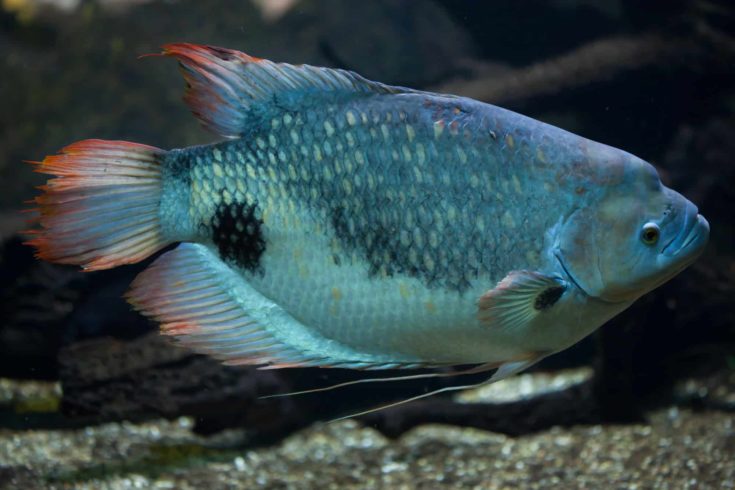
Wild Blue gouramis can grow to reach six inches, but captive fish are generally a little smaller than that.
Life Expectancy
Blue gouramis are quite long-lived in captivity, often surviving for up to five years or more with excellent care.
Activity Level/Temperament
The Blue gourami is generally considered to be a peaceful community fish when small. However, they can become belligerent as they get larger, sometimes picking on smaller fish. That said, some are shy and timid. It really depends on the individual fish.
These fish are generally slow-moving, gliding sedately around the tank, simply looking beautiful!
Compatibility and Tankmates
I recommend a mix of peaceful fish as tank mates for Blue gouramis.
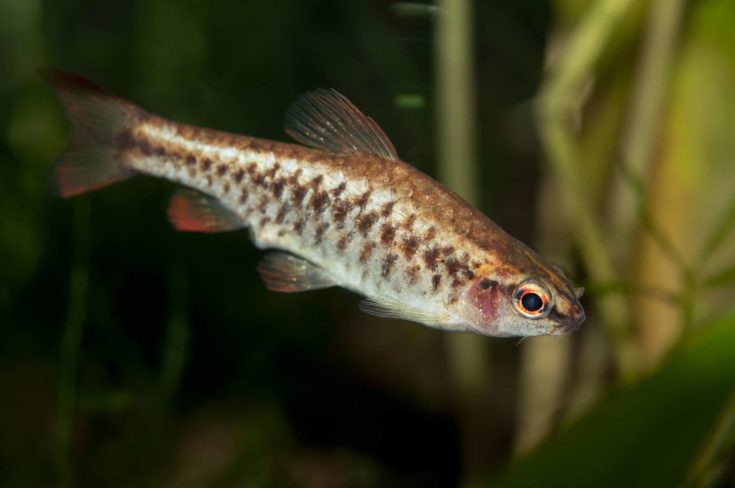
You should avoid including fish that will antagonize the gouramis, especially fin nippers. Also, tiny fish and fry will be viewed by the Blue gourami as a food source.
Tank Mates
Suitable tank mates for Blue gouramis are some of the Cyprinids, such as barbs, larger Characins, and loaches.
You can keep these fish with other large gouramis, although they can often bully each other. Also, male Blue gouramis are territorial, and they will become extremely aggressive during spawning.
Diet and Nutrition
To keep your Blue gouramis healthy and to produce the best colors, always feed your fish high-quality, nutritious foods.
What to Feed Your Blue Gouramis
Blue gouramis are omnivores, eating a diet of meaty protein and some plant matter.
These fish will eat all kinds of flake foods, freeze-dried, frozen, and live foods. A balanced, nutritious diet consists of tropical flakes or pellets supplemented with bloodworms, brine shrimp, tubifex worms, and some blanched zucchini or lettuce.
How Much and How Often to Feed Blue Gouramis
I recommend that you feed your Blue gouramis two or three times a day.
Only offer the fish enough food to keep them busy for a few minutes so that you don’t overfeed them.
Tank Requirements
Tank size
You can keep young Blue gouramis in a 20-gallon tank with a few tank mates, but you’ll need to increase that as the fish grow to their full adult size. Add an additional gallon of water per inch of fish if you decide to increase your stocking levels.
Since these fish are labyrinth breathers that need to get to the surface to breathe and feed, a long tank is preferred to a tall one. Long aquariums also provide more swimming space and facilitate better gaseous exchange, so the water will contain more dissolved oxygen.
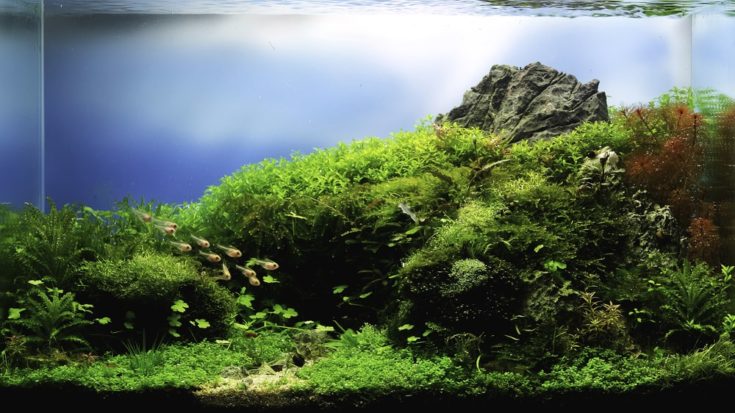
Gouramis can jump, so make sure that your tank has a cover slide or lid.
Tank Setup
Substrate
Any kind of substrate is fine for Blue gouramis, although a dark medium shows up the fish’s colors especially well.
Decoration
Dense planting and plenty of smooth driftwood, rocks, and caves make the perfect decoration for a gourami tank. Try to arrange things so that each fish can mark out a territory and provide hiding places for shy tank mates.
Habitat Requirements
Filtration
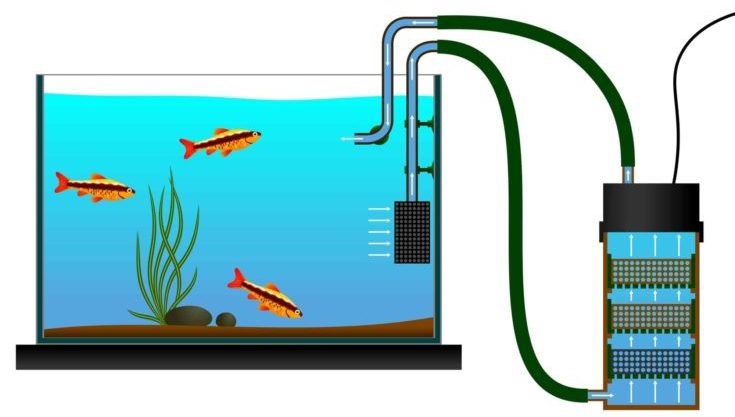
Blue gouramis live in slow-moving water, so an external filter such as a canister or HOB system is the best choice.
Water Parameters
Water Temperature
Blue gouramis are tropical fish requiring a water temperature of between 73° and 82° Fahrenheit. To avoid damage to the fish’s labyrinth organ, the ambient room temperature should be as close to the water temperature as possible.
Water Hardness and pH Range
The water pH needs to be between 6.0 and 8.8, with a water hardness of 5 to 35 dGH.
Lighting
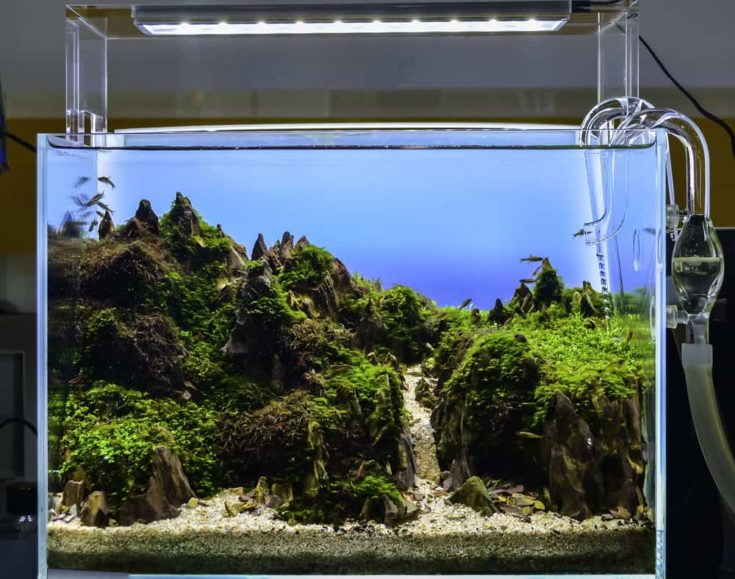
The lighting in the aquarium should be normal to moderate. If you want to add shade, try including a few floating plants.
Tank Maintenance
To keep the tank clean and healthy for your fish, carry out partial water changes of around 25% every week.
Once a month or so, wash the filter media in aquarium water to get rid of sludge, and replace old media as per the manufacturer’s guidelines.
Lighten the load on your biological filter by vacuuming the substrate to get rid of decomposing organic matter that would otherwise pollute the water.
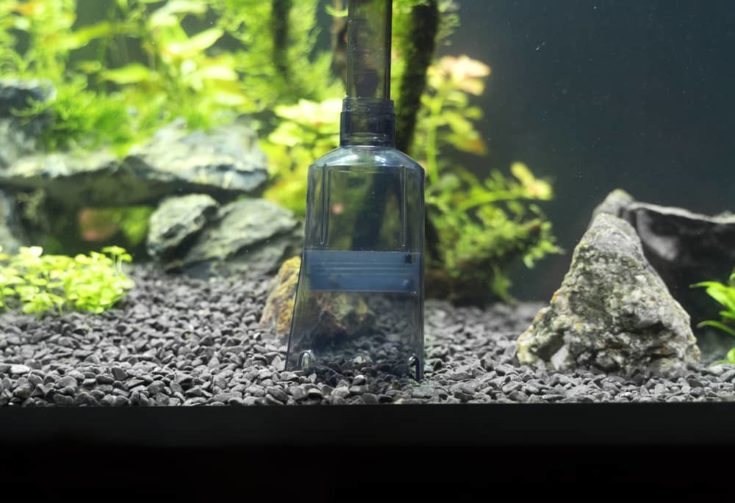
Remove algae from the tank glass with an algae magnet.
How To Set Up Your Aquarium
Assemble everything you need to set up your aquarium, including:
- Dark substrate
- Driftwood, smooth stones, caves
- LED lighting unit
- Water conditioner
- HOB or canister filter unit
- Heater
- Aquarium thermometer
- Live plants
How To Do It:
- Wash dust and debris from the substrate.
- Add a few inches of the substrate to the tank. Set an upturned dish or smooth rock on the substrate in the middle of the aquarium.
- Plug in the filter unit and heater but don’t switch them on.
- Fill the tank as far as the fill line with dechlorinated tap water, pouring the water over the dish or rock so that you don’t disturb the substrate.
- To initiate the nitrogen cycle , the water must contain some ammonia. So, put a few pinches of fish food in the water, add some drops of pure ammonia, or a cup of gravel from a mature aquarium.
- Wash the tank decor and arrange everything in the tank.
- Prepare living plants by cutting off any dead leaves and broken stems. Add the plants to the tank.
- Turn on the heater and filter unit. If you’ve added living plants, you’ll need to give them eight to ten hours of light each day to photosynthesize. So, if you have a timer, be sure to set it.
Allow the tank to cycle for at least ten days. However, you should know that it can take up to two months for a tank to cycle fully.
Test the aquarium water every day or two until the ammonia and nitrite levels fall to zero and nitrate levels are under 20ppm or thereabouts. Now you can add a few small fish to your tank!
Keep testing the water, and once the levels remain stable, you can add some more fish.
Health and Disease
Blue gouramis are extremely hardy and not prone to many diseases. However, poor water quality, an incorrect diet, and stress are all major causes of sickness in aquarium fish.
Signs of Good Health
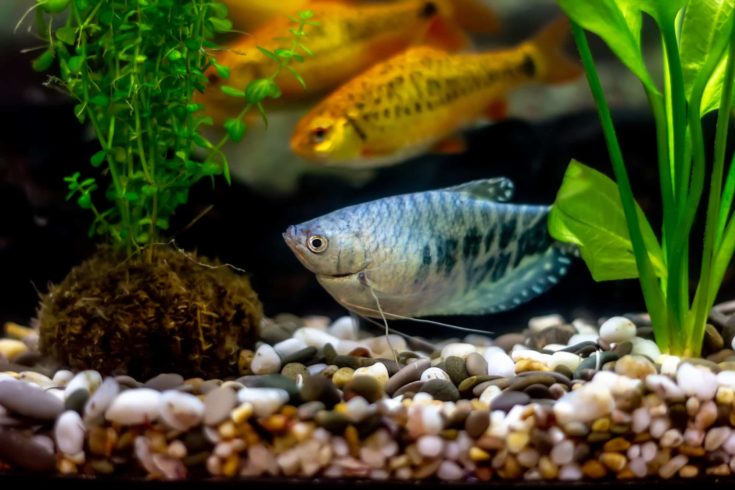
Blue gouramis are generally pretty chilled-out dudes in the tank, swimming slowly around the mid to upper area of the water column.
Red Flags
Danger signs to be aware of include:
- Loss of appetite
- Inactivity
- Ulcers, sores, red patches on the body, or red streaking in the fins
- Flashing the body against solid objects in the tank, including the substrate
Common Health Issues and Treatments
Health Issue
Ich (White Spot Disease)
Symptoms or Causes
Ich is also commonly known as White Spot disease and is caused by a species of aquatic parasite.
Fish with Ich develop a scattering of little white spots on the gills, fins, and body, and usually flash or rub themselves against solid objects in the aquarium.
Recommended Action
Elevate the water temperature to 82o F for three days. Simultaneously, treat the tank with an OTC Ich medication.
Health Issue
Flukes
Symptoms or Causes
The term flukes is used to describe various species of external fish parasites. Flukes can often be seen with the naked eye, latched on to the fish’s gills or body.
Recommended Action
Treat the fish tank with an antiparasitic drug.
Health Issue
Fungal infection
Symptoms or Causes
White cotton-like growths around the fish’s mouth, head and body.
Recommended Action
Quarantine any infected fish, and treat with antifungal treatment.
Health Issue
Bacterial infections
Symptoms or Causes
Bloody, shredded fins, red areas, sores, and ulcers on the body.
Recommended Action
Treat the tank with antibacterial medicine.
Breeding
Blue gouramis can be bred quite easily in captivity.
Set up a shallow spawning tank of 10 to 20 gallons, using plenty of lush planting. Elevate the tank temperature to 80o Fahrenheit, and offer the fish a diet of live, high protein food to bring them into spawning condition.
The male fish will build a large bubble nest. Once the nest is complete, the male will court the female, eventually mating with her. When the eggs are deposited, the male transfers them to the bubble nest and will guard them until the eggs hatch.
Once spawning is complete, remove the female, as the male will become aggressive toward her. When the fry are free-swimming, remove the male or he might eat the fry. Feed the fry infusoria or liquid fry food, then baby brine shrimp once they’re large enough to eat it.
Availability
Blue gouramis are readily available online and in fish stores for around $10, depending on the size of the fish.
Product Recommendations
- Water dechlorinator
- Algae magnet
- Aquarium thermometer
- Aquarium vacuum
- Books on tropical fish husbandry
- HOB or canister filter
- Fish tank (minimum size 20 gallons)
- Heater
- High-quality tropical fish flakes, pellets, frozen food
- LED lighting unit
- Living plants
- Smooth stones, driftwood, caves
- Dark colored substrate
In Conclusion
I hope you enjoyed our guide to the beautiful Blue gourami.
These gorgeous labyrinth breathing fish make a very attractive addition to a peaceful community tank. Blue gouramis, they are ideal for a beginner to the hobby, being hardy and easy to care for.
If you have Blue gouramis, what color variants do you keep? Have you successfully bred them in your home tank? Tell us in the comments box below.
And, please remember to share this article if you loved it!